#sindhi people
Explore tagged Tumblr posts
Text

#poetry#ali gohar jatoi#aligoharjatoi#photoshop#adobe#authors#books & libraries#branding#character design#data science#design#digital illustration#sindhi people#sindh#river#pakistan#public figure#historical people#$#personality#education
2 notes
·
View notes
Text
the contrast between my brother who calls to tell my parents literally everything that happens ("i did my laundry" "i'm going to see a match among students" "the girls here dress skimpy" (theyre just wearing crop tops and/or shorts in 32° weather) "this is what i'm wearing" etc etc), they know about each of his friends by name and where they are and what they're doing and they ask about each of them ("how is A settling in in canada?" "has B talked to you yet?") and me who doesnt want to tell my parents anything, everything they know, theyve dragged out of me with so much resistance they couldve been pulling teeth.
i told them i had a friend in pakistan who goes to uni there and my dad goes "you have a friend in pakistan? how do you know them?". fucking insane bro. he didnt even know i had a friend in pakistan, let alone anything else. i genuinely didnt know i'd never talked about him lmfao. i changed the subject to my cousin who also goes to uni in the same city (thats what we were talking about, and i didnt want to talk about him and potentially reveal he's a guy cause then they'd ask questions about that)
its also so odd to refer to my male friends as if theyre female lol so im just kinda bouncing back and forth between using female versions of words and male versions and i barely know what im saying lmfao. (you use different words if youre talking about a guy vs a girl, in sindhi the word for "one" as in "one friend" is "hikro" if youre talking about a guy and "hikri" if youre talking a girl, i used "hikro" and my brother who was on facetime at the time corrected me and said "you'd use hikri" assuming the friend in question was female and i was like whatever there isnt a difference you get what i mean lmfaoo)
my siblings also get so surprised when i talk about anyone. i once told my soster about one of my friends and she stalked my followers/follows to see if they were real and she told me and i removed her from my followers (i later remembered j had a public account and it didn't actually matter), and my brother a few days later asked why she wasnt following either of her siblings, me or him, and i said that i removed for looking at my friends' profiles and she defended herself like jokingly yelling "ONE friend, i only looked at ONE friend" and my brother who's just saw this exchange goes "you have friends?" BRO???? WHAT????
but genuinely i fucking hate anyone in my family knowing anything about my friends but i dont mind the opposite, i've sent my friends pictures (one picture) of my parents and they know so much shit about them and my life lmaoo.
i just think its so funny
#my friends#and#my parents#in a way#also me revealing im sindhi💪#my brother's very recently traveled to his uni in a different country#a country he's never been to before#and im fairly certain he's homesick asf#he's making it really obvious#he calls every day#often multiple times a day#send a shitton of pictures#sometimes i wonder if he has any close friends#cause i would send those pictures to my friends#not to the family gc#but then again i wouldnt want to tell anyone in my family anything about me so thats a factor#sends*#and every time he calls he talks about how he can't wait to get back#lmfaoo#im like shut up#not out loud tho#my dad did tho#i said to him <brother's name> is acting so weird#like we're complete opposites cause i would love to get out and live somewhere else#and he said to me thats how your brother thought too when he lived here#but today when my brother was complaining and saying how he couldnt wait to get back#dad was like be grateful what you have is some people's dream#and he was like yeahhhhh#anyway
1 note
·
View note
Text
the common claim that "the majority of punjabis are sikh" is a false one and i feel important to remind people from time to time because it plays into hindutva and otherwise islamophobic beliefs that are not rooted in reality esp rn with sanghis on this website running rampant and getting cozy with zionists lol islamophobia is one of the common threads between these ideologies
the notion that only punjabis who ended up on the indian side of the partition are "true punjabis" while pakistani punjabis and muslim punjabis are "false punjabis" is both islamophobic and nonsensical. there are 112 million punjabis in pakistan and only 38 million punjabis in india. more than 112 million people worldwide are punjabi muslims while there are 28 million punjabi sikhs and less than 20 million punjabi hindus. there are more than double the amount of punjabis in pakistan than in india. the majority of punjabis on earth are pakistani and muslim and that is not a bad thing, it's a completely neutral piece of information.
the reason pakistani muslim punjabis are not "counted" as punjabi when people make the claim that "most punjabis are sikh" is purely due to islamophobia. we all speak the same language and eat the same food and wear the same clothing. there is no "innate" punjabi-ness that can be gained or lessened, nor "tainted" or "cleansed" depending on the religion you follow. the idea that there is something fundamentally different about punjabis who are muslim or punjabis who ended up on the pakistani side of partition is insane
sanghis love to claim that sikhs are hindus / categorize us as hindus while simultaneously treating us as savage brutes looool
#edited to break up the text#punjabis as a distinct ethnic group only came about in the last few hundred years#this only happened in the 1700s. before that we were a loose collection of tribal groups and castes#people move around and shift and change thats what people do#we and sindhis were not even separate groups until at some point in the last 1000 yrs iirc#& no matter what religion you follow if you speak punjabi youre treated as an uneducated brute by hindi speakers
187 notes
·
View notes
Text
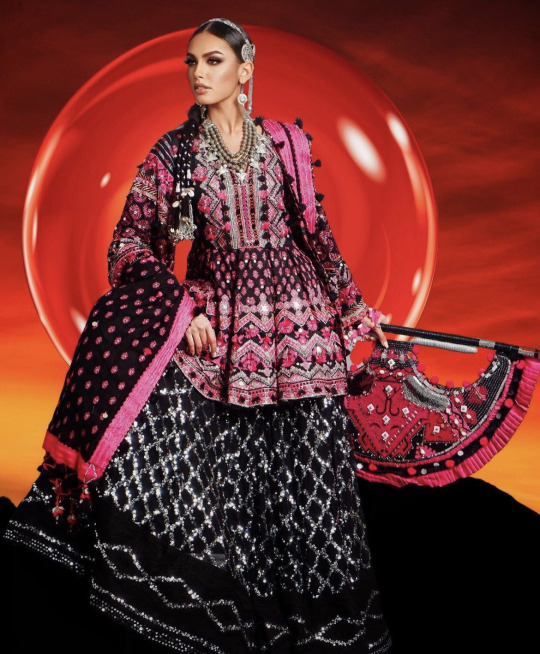

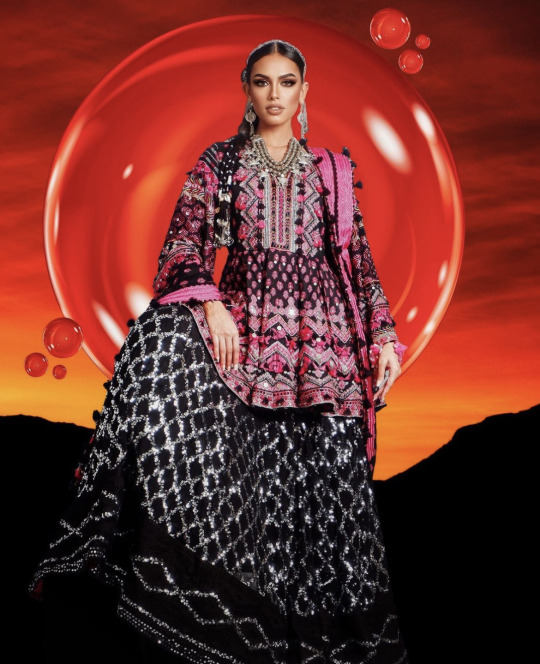
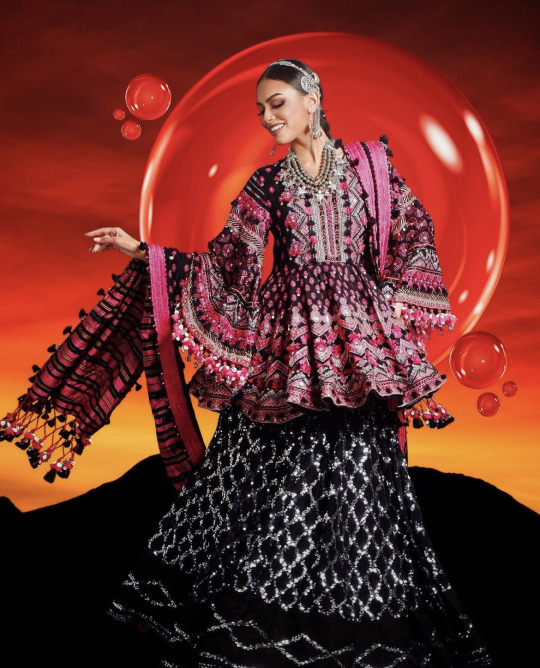

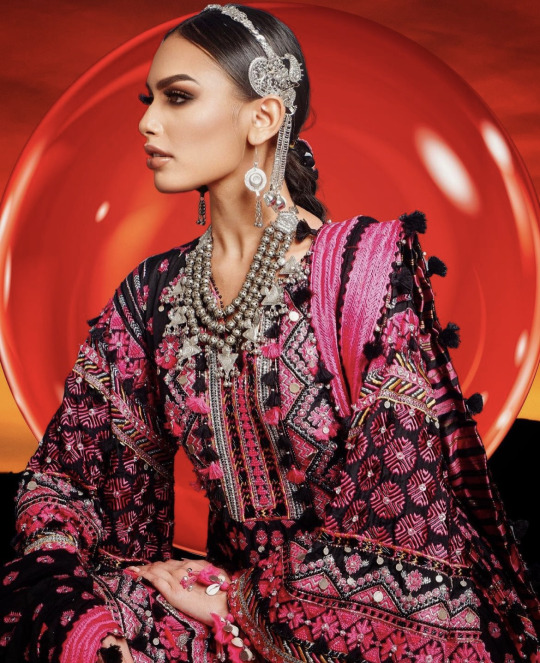
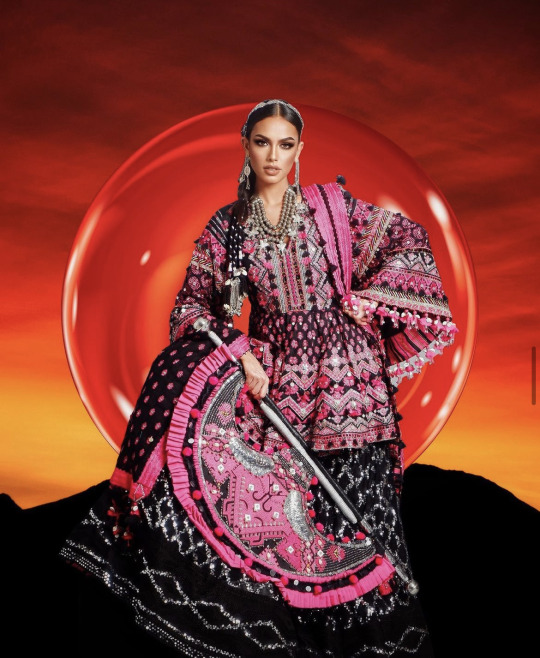

Miss Universe Pakistan 2023 National Costume
The name of the National Costume is Pehchaan or in English 'Identity' Meaning: the distinguishing character or personality of an individual: INDIVIDUALITY Everyone has their own Pehchaan (Identity Miss Universe Pakistan message on her national costume is 'Unity in Diversity by celebrating its own Identity' Erica aims to celebrate the rich and diverse culture, history and lifestyle of Pakistan through her outfit. Pakistan is home to multiple ethnicities based on region, religion, language, and culture. Few of the existing ethnicities include Baloch, Brahui, Sindhi, Punjabi, Muhajir, Saraiki, Memon, Kalashi, Balti, Wakhi, Afghani, Kashmiri, and Hindkowan. This costume is a vibrant celebration of Pakistan's diverse cultures, seamlessly weaving together its distinct beauty and the profound love and unity embedded in its people's hearts. The intricate patchwork blends the rural and urban elements, paying homage to the rich crafts and heritage of Pakistan. The handcrafted fan, a major part of Pakistan's tribal lifestyle, is a symbol of power, and elegance and an ode to its roots. Meanwhile, the grand silhouette serves as a powerful visual testament to Pakistan's remarkable growth and evolution over time. It embodies the nation's journey from its roots in tradition to its strides toward modernity since gaining independence.
118 notes
·
View notes
Text
In a daughter. Stay. Aati Asi.
In a lay of me, I draw daughter. I was daughter. I was love to know, day. Day barks like dogs teeth. I was Day. Day sings me like an uncomfortable poem. She wears. Me like a bra hook. I was holding me like a dog chain. In a can, you mean to drink my water. I was singing mom. I was eating love. I was greed Sunidhi. Deed Sindhi. I was greed. I was daughter I was abscond. In a stay of man, I was her. In a daughter! I was. I was staring bra hooks. Her feet broke. In jeopardy, I was caught at the act of staring bra feets. In a good English, I was man. Makes me, daughter. I was a daughter. In a me, I was me. In me. Rape-judicial sect into a man kind. And her feet saw her mother to be. She saw in me, nation of blood and chest wind still as wound, in a spill if words and she found matter mother. The scare of mother liked her. In a digging if fight, I wore English. I write. I love bloodhound. I bound. I ask. In a name, she loves me like fire. She kisses chin. In a taught if or people, I have tight of teaching. She was abs
cond.
I'm a teacher of way. I teach me. I want the love of me. I was the feet of me luck. In a suck of me, suck. I was suck. In a whole of tragedy, shri won. Her title. She taught and knew how to take an act of people. In love, he denied. I was me. I was daughter. Love denied. Love was her. She loved. In an embed, she was naked. Prying in imagination. I love her English. Because she is me. Beat me into your wood. She is me, if love was a greed of mine, I would love. I enjoy raw people. Raw English. She loves like God. Like a play. She kissed me in the chin and said and love, you leave me naked like a man's painting eye.
Layers of man. In a girl, she died. I was a mother, I'm a kiss of hers. I'm a snippet of me, showing.
Sunidhi



#spilled writing#spilled poetry#spilled words#writers and poets#writers on tumblr#writeblr#spilled thoughts#female writers#writing#the english language#poets on poetry#poetic#love poems#poets on tumblr#poems poetry#poets corner#poemas#poem#dead poets society#poetry corner#poems and poetry#poems on tumblr#the tortured poets department#poetry#original poem#poetslife#poems about love#poet#poems and quotes#poemsbyme
8 notes
·
View notes
Text
Spanish?
i need to learn one more language to annoy even more people
#all ppl who know russian also know english more or less well its unfaaaiiiirrr#<-nah i getchu tbh skshsi#literally half the people i know irl are trilingual#because urdu is only the national language...there are other ones like pashto and punjabi and sindhi and balochi...#i wish i knew pashto#smh
15 notes
·
View notes
Text
A Leader Among Real Estate Giants: Niranjan Hiranandani

The Indian real estate sector has witnessed immense growth, driven by visionary leaders in real estate who have redefined urban landscapes. Among the pioneers who have left an indelible mark on the industry, Dr. Niranjan Hiranandani stands out as a leader who has reimagined urban living, creating vibrant, self-sufficient communities that blend innovation with sustainability. His transformative approach to urban planning has reshaped cities, setting new standards for top real estate leaders in India.
The Rise Of A Real Estate Visionary
Dr. Niranjan Hiranandani’s journey in real estate is a testament to perseverance, innovation, and an unwavering commitment to excellence. Dr. Niranjan Hiranandani’s leadership is deeply rooted in his educational background and Sindhi heritage, which emphasizes entrepreneurship and resilience. After earning a B.Com degree and becoming a Chartered Accountant, he ventured into real estate—a sector that was in dire need of innovation. In an era when quality housing and infrastructure were still evolving, he introduced integrated townships, setting new standards in design, planning, and execution.
Despite industry challenges, such as regulatory constraints and evolving market dynamics, he pioneered new approaches to urban development, focusing on self-sustaining ecosystems where residents could live, work, and thrive. His ability to anticipate market needs and overcome obstacles led to the creation of landmark projects and positioned him as a leader who would transform India’s real estate sector.
Transforming Real Estate In India
Under Niranjan Hiranandani’s leadership, the Hiranandani Communities have developed some of the most iconic urban spaces, revolutionizing city planning and infrastructure. His signature projects, such as Hiranandani Gardens in Powai, Hiranandani Parks in Chennai, and Hiranandani Fortune City in Panvel, transformed underdeveloped areas into thriving urban hubs, redefining real estate development in India At the core of his philosophy lies the concept of integrated townships—self-contained communities with residential, commercial, and recreational facilities. This model has not only enhanced the quality of urban life but has also inspired a new wave of sustainable and well-planned developments across the country. His emphasis on sustainable urban planning has further set new industry benchmarks. By incorporating green construction practices, smart infrastructure, and energy-efficient designs, his projects reflect a deep commitment to environmental responsibility while offering residents a superior quality of life. He has set benchmarks in leadership in Indian real estate.
Key Leadership Traits That Set Him Apart
The success of Niranjan Hiranandani’s leadership in real estate is driven by:
Visionary Thinking – He foresaw the demand for integrated, sustainable townships long before they became a trend.
People-First Approach – His leadership style focuses on building trust and long-term relationships with customers, employees, and stakeholders.
Resilience and Adaptability – Navigating market fluctuations, regulatory changes, and economic challenges has been key to his success.
Innovations Introduced Under His Leadership
A true visionary leader in real estate, Niranjan Hiranandani has consistently introduced innovative solutions to the sector, including:
Green and Sustainable Construction – Implementing rainwater harvesting, energy-efficient buildings, and eco-friendly materials.
Smart Townships – Leveraging technology-driven infrastructure for enhanced convenience.
Diversification Beyond Residential Spaces – Expanding into IT parks, commercial hubs, and healthcare facilities to create mixed-use developments. His contributions have influenced the next generation of real estate developers, proving that Niranjan Hiranandani’s leadership way is one of constant evolution and forward-thinking strategies.
Mentorship And Industry Influence
Beyond real estate development, Niranjan Hiranandani plays a key role in mentoring future leaders in the industry. As a founding member of NAREDCO and CREDAI, he actively participates in shaping real estate policies that benefit the sector. His leadership extends beyond his own projects, advocating for transparency, regulatory reforms, and industry-wide improvements.
Balancing Vision And Social Responsibility
One of the hallmarks of Niranjan Hiranandani’s leadership is his commitment to social responsibility. He has made significant contributions to education, healthcare, and sustainability, ensuring that his impact extends beyond real estate. Through philanthropic efforts and environmental initiatives, he reinforces the idea that business success and social progress must go hand in hand.
Lessons From Niranjan Hiranandani’s Leadership Journey
Aspiring entrepreneurs and industry professionals can learn from Niranjan Hiranandani’s leadership by adopting:
Integrity and Transparency – Building trust is key to long-term success.
Innovation and Quality – Success comes from offering solutions that are sustainable and future-proof.
Customer-Centric Growth – Understanding and fulfilling market demands is crucial in leadership in Indian real estate. His journey serves as an inspiration for real estate professionals looking to balance personal values with professional ambitions.
Conclusion: A Legacy Of Leadership
From pioneering integrated townships to advocating for sustainability and innovation, Niranjan Hiranandani’s leadership in real estate has left an indelible mark on the industry. His visionary approach has set new benchmarks, influencing top real estate leaders in India and shaping the future of urban living. His legacy as a transformative leader continues to inspire a new generation of entrepreneurs, proving that strong leadership can redefine an entire industry.
Faqs
1. What Are The Key Leadership Traits Of Niranjan Hiranandani?
His leadership is defined by visionary thinking, adaptability, and a customer-first approach that prioritizes long-term value.
2. How Did Niranjan Hiranandani Revolutionize Real Estate In India?
He introduced integrated townships, sustainable urban development, and innovative commercial spaces, transforming city infrastructure.
3. What Projects Highlight Niranjan Hiranandani’s Leadership In Real Estate?
Notable projects include Hiranandani Gardens in Powai, Hiranandani Parks in Chennai, and Hiranandani Fortune City in Panvel.
4. How Does Niranjan Hiranandani Inspire Future Leaders?
Through mentorship, industry advocacy, and thought leadership, he guides aspiring real estate professionals.
5. What Is Niranjan Hiranandani’s Impact On Sustainable Development?
His focus on green construction, eco-friendly townships, and smart infrastructure has set new industry standards.
9 notes
·
View notes
Note
Arabic, Spanish, French, Japanese, Mandarin, and Latin in canon is what Damian speaks. However, Nanda Parbat is based off of a mountain range in Pakistan so it's possible he would also know Punjabi, Pushto, Sindhi, Saraiki, Urdu, and Balochi. Talia I think is partially chinese so she would probably teach Damian Yue (Cantonese), Xiang (Hunanese), Min dialect, Gan dialect, Wu dialect, and Kejia or Hakka dialects. She is also Arabic so that would mean she would probably speak either Najdi Arabic, Hejazi Arabic( aka Hijazi Arabic) or West Arabian Arabic. She would probably also teach Damian those.
- 💀
★°•.: Damian is said to speak multiple different languages, including the first few that you mentioned he speaks in canon. don't worry skull Anon, I've done my research 🤧
Either way, I do believe that Talia saw it fit that Damian should learn more than just the main ones that most people mention of Damian speaking. He's a very diverse character, and basically a genius when it comes to these kind of things.
Its alot like the fact that people forgets he can mimick anyone's voice to perfection as well, and speak as them!
9 notes
·
View notes
Text
15 Fairy Tales, Fables, Legends, Myths, and Folklore books by BIPOC Authors
Every month Book Club for Masochists: A Readers’ Advisory Podcast chooses a genre at random and we read and discuss books from that genre. We also put together book lists for each episode/genre that feature works by BIPOC (Black, Indigenous, & People of Colour) authors. All of the lists can be found here.
Women Wide Awake: Stories, Sculptures and Poems From Sindhi Folklore by Nimra Bandukwala and Manahil Bandukwala
Blue Bamboo: Japanese Tales of Fantasy and Romance by Osamu Dazai, translated by Ralph F. McCarthy
The Annotated African American Folktales by Henry Louis Gates Jr. and Maria Tatar
Blackberry Blue: And Other Fairy Tales by Jamila Gavin
Her Stories: African American Folktales, Fairy Tales, and True Tales by Virginia Hamilton, illustrated by Diane Dillon and Leo Dillon
The Dragon Slayer: Folktales From Latin America by Jamie Hernandez
Laughing with the Trickster: On Sex, Death, and Accordions by Tomson Highway
Legends of Vancouver by E. Pauline Johnson
Living Ghosts & Mischievous Monsters: Chilling American Indian Stories by Dan SaSuWeh Jones, illustrated by Weshoyot Alvitre
An Introduction to Yōkai Culture: Monsters, Ghosts, and Outsiders in Japanese History by Komatsu Kazuhiko, translated by Matt Alt and Hiroko Yoda
Rediscovering Turtle Island: a First Peoples' Account of the Sacred Geography of America by Taylor Keen
Night Stories: Folktales From Latin America by Liniers
Mangoes, Mischief, and Tales of Friendship: Stories From India by Chitra Soundar, illustrated by Uma Krishnaswamy
Vietnamese Folktales for Children: Stories of Adventure and Wonder in Vietnamese and English by Phuoc Thi Minh Tran, illustrated by Dong Nguyen and Hop Thi Nguyen
The Little Hummingbird by Michael Nicoll Yahgulanaas
5 notes
·
View notes
Text

yelling and screaming about the B lore drop.
stories in FL giving a small nod to the erasure and forms of violence done to the cultures under the British Empire

#Avci/The Director's father was a sindhi lascar#though they chose in the end to adopt their mother's name over the anglicized name the Navy had on file#though that was in part because of the relationship#but their whole thing is the compromise of identity and the conflict involved when you mold yourself to a system#built by the colonizers of your people and built to keep you out#but B losing their name and realizing the prison of the Neath that's kept them from the culture that makes up part of who they are!! TT
28 notes
·
View notes
Text

بڑے اور عظیم خواب دیکھنے والا کبھی چھوٹا نہیں ہوتا
#ali gohar jatoi#poetry#photoshop#adobe#authors#books & libraries#branding#character design#data science#design#digital illustration#people#public figure#publicsector#world#sindhi people
1 note
·
View note
Text
A2 vs A1 Ghee: What’s the Difference and Why It Matters?

In this blog, we delve deep into the A2 vs A1 Ghee debate and explore why the difference truly matters.
Looking for authentic A2 Ghee? Explore our offerings at Natures Adhaar, your trusted source for pure, Bilona-made A2 Gir Cow Ghee.
1. Understanding the Basics: What Are A1 and A2 Ghee?
To understand A2 and A1 ghee, we must first understand milk proteins. Cow's milk contains two primary types of beta-casein proteins: A1 beta-casein and A2 beta-casein. The presence of these proteins depends on the breed of the cow.
A2 milk comes from indigenous Indian cows such as Gir, Sahiwal, and Red Sindhi. The ghee made from these cow’s milk is called A2 Ghee.
A1 milk, on the other hand, comes from foreign breeds like Holstein Friesian and Jersey cows, which are often crossbred for higher milk yield.
The key difference lies in the structure of the beta-casein protein. While A2 beta-casein is considered natural and easier to digest, A1 beta-casein breaks down into a peptide called BCM-7 (Beta-Casomorphin-7), which some studies suggest may have adverse health effects.
2. The Making Process: Traditional vs Industrial
Another fundamental difference is how the ghee is made.
A2 Ghee is traditionally made using the Bilona method. This involves curdling the milk, churning it to extract butter, and then heating the butter to make ghee. It is a slow, labor-intensive process but retains nutrients and aligns with Ayurvedic principles.
A1 Ghee is usually produced in bulk using the direct cream method, where cream is separated from milk and heated directly to make ghee. This method prioritizes quantity over quality and often lacks the nutrient density of bilona ghee.
The traditional approach used for making A2 Ghee preserves healthy fats, vitamins, and medicinal properties, making it a superior health product.
3. Health Implications: Which Ghee Is Better for You?
A2 Ghee has been associated with a host of health benefits:
Easier digestion: A2 beta-casein doesn’t form BCM-7, which makes it gentler on the gut.
Rich in Omega-3 fatty acids and CLA: Helps improve heart health and boosts metabolism.
Supports brain development: Thanks to its high levels of saturated fats and fat-soluble vitamins like A, D, E, and K.
Anti-inflammatory properties: Promotes joint health and strengthens the immune system.
In contrast, A1 Ghee is believed to:
Be harder to digest for some individuals
Possibly trigger allergic reactions or lactose intolerance symptoms
Contribute to inflammation in sensitive people due to the BCM-7 compound
While more research is still ongoing, many health-conscious individuals and Ayurvedic practitioners prefer A2 Ghee for its holistic benefits.
4. Ethical and Environmental Considerations
Choosing between A1 and A2 Ghee also involves a consideration of ethics and sustainability.
A2 Ghee supports native Indian cow breeds, which are often neglected or crossbred for higher yield. By purchasing A2 Ghee, consumers help preserve these indigenous breeds and the traditional farming systems that care for them.
The Bilona method used to make A2 Ghee is usually practiced by small-scale farmers, ensuring fair trade, sustainable practices, and animal welfare.
In contrast, A1 Ghee production is often industrialized, with cows raised in confined spaces and subjected to hormonal treatments and unethical practices to boost milk output.
When you choose A2 Ghee, you're not just choosing a healthier product, but also supporting eco-conscious and ethical farming.
5. Why It Matters: Making the Right Choice for Your Health and Future
In a world full of choices, understanding what you consume is the first step toward better health. The difference between A2 and A1 Ghee may seem subtle on the surface but has far-reaching impacts on your body, mind, and the environment.
Here’s a quick comparison:

At Natures Adhaar, we are proud to offer pure, traditionally made A2 Gir Cow Ghee that stays true to India’s roots. Our cows are grass-fed, loved, and cared for in a stress-free environment. Each batch of ghee is made using the age-old Bilona method, ensuring that you get the best of nature in every spoon.
Good Decision for Your Holistic Living
The choice between A2 and A1 Ghee is not just about taste or price – it's about health, heritage, and holistic living. By choosing A2 Ghee, you invest in a product that nourishes your body and supports sustainable agriculture.
So the next time you're shopping for ghee, remember to look beyond the label. Choose A2 Desi Cow Ghee for a healthier you and a happier planet.
Switch to purity. Choose Natures Adhaar.
#a2 ghee#a2 cow ghee#ghee#a2 desi ghee#desi cow ghee#Natures Adhaar#ecommerce#recipes#startup#success
2 notes
·
View notes
Text
Main Languages Spoken in Pakistan
Pakistan is a linguistically diverse country with a rich cultural heritage, home to numerous languages spoken across its provinces and regions. Each language reflects the identity and traditions of its people. Here are some of the main languages spoken in Pakistan:
Urdu
Urdu is Pakistan’s national language and serves as a unifying medium across the country. It is widely spoken and understood, especially in urban areas. Urdu poetry and literature hold a special place in the cultural landscape of Pakistan. Explore Urdu phrases for travelers.
Sindhi
Sindhi is spoken in Sindh province and is known for its ancient literary heritage and deep connection to Sufi poetry. The language is written in a script derived from Arabic and is rich in folklore and traditional music. Learn Sindhi phrases to connect with locals.
Punjabi
Punjabi is the most spoken language in Pakistan, primarily in Punjab province. It is vibrant and expressive, famous for its folklore, songs, and Bhangra dance. The language is written in Shahmukhi script in Pakistan. Discover Punjabi phrases for your trip.
Pashto
Pashto is spoken in Khyber Pakhtunkhwa and parts of Balochistan. It is a key part of the Pashtun culture, rich in oral traditions, poetry, and hospitality practices. It has its own script and distinctive linguistic style.
Balochi
Balochi is the primary language of Balochistan. It has ancient roots and is influenced by Persian and Arabic. The language is known for its storytelling traditions and epic poetry.
Seraiki
Seraiki is spoken in southern Punjab and parts of Sindh. Known for its soft and melodic tone, it is closely related to Punjabi and has a strong tradition of folk music.
Brahvi
Brahvi is a Dravidian language spoken in Balochistan. Its unique linguistic roots make it distinct from the surrounding languages. It is often associated with the cultural identity of the Brahvi-speaking tribes.
Shina
Shina is spoken in Gilgit-Baltistan and is a key language in the mountainous northern regions. It is vital to preserving the oral traditions and stories of the region.
Broshiski
Broshiski is an isolate language spoken in Hunza and Nagar Valleys. It has no known linguistic relatives and is treasured for its cultural significance.
Balti
Balti is a Tibetan-origin language spoken in parts of Gilgit-Baltistan, including Skardu. Its script and traditions reflect a mix of Buddhist and Islamic influences.
Chitrali (Khowar)
Khowar, or Chitrali, is spoken in Chitral and surrounding valleys. It is known for its poetic nature and deep connection to the region’s mountainous culture.
Makrani
Makrani is a dialect spoken by communities in southern Balochistan and coastal Sindh. It blends influences from Balochi, Sindhi, and Swahili, reflecting the area's maritime heritage.
Learn Local Languages with Travel & Culture
Travel and Culture in Pakistan offers specialized tours for those interested in learning local languages and exploring the cultural diversity of the country. Find more at Travel & Culture.
#Pakistan#Pakistani languages#Urdu#Sindhi#Balouchi#punjabi#pashto#travel#Paksitani languages#phrases
3 notes
·
View notes
Note
i always read the ironborn as south asian, specifically sindhi (from pakistan)! the bawarij pirates sailed barija, a type of dhow that are unsuited to warlike maneuvers. they kinda look like longships, which the ironborn use. obviously gurm didn't completely base the ironborn (or any ethnic group) on people in real life, but i like to think he drew some inspiration from the bawarij pirates when writing the ironborn. also, gurm describes theon as "dark" which i think is interesting!
that's SUCH a cool headcanon, i liked chinese ironborn too cos of the historical south china sea chinese piracy during the 1700s/1800s. whenever grrm uses dark or fair thats technically in reference to their hair and general aesthetic but i hate when people use that as a gotcha cos like can you PROVE it? naur!
#i would disagree cos he for sure based the ironborn on vikings but like the pop culture idea about vikings#ask#mattressstoreddx
14 notes
·
View notes
Text
Google Translate Writes: Will, the Bog Monster
Hey, look what day it is - it's April Fool's Day! We all know what that means: It's time for the fourth annual Google Translate Writes! For those who haven't read them yet, every year I take a light-hearted oneshot of mine and put it through ten layers of Google Translate, then post the results here on Tumblr (and now on ao3 too!). This year, we're doing Will, the Bog Monster, a quick lil thing I wrote nearly a year ago. Read it at the link - then look below the cut (or on ao3!) to see how this simple story survived being translated into Corsican, Shona, Basque, Hausa, Belarusian, Nepali, Afrikaans, Lao, Sindhi, and Urdu!
Yes, Demon Lord
After five years, Hill thought he would learn about parenting. He left Will in the ward for the long missions, traveled to Will and stayed with the people on the short missions. In a few years from Wensley, when she's more confident, maybe start dating him. Will was now loud and reckless, preferring to play rather than be quiet, and Halt saw no harm in being quiet for a while.
Love is a good thing, all things considered. It is very social, social and social. He was slightly intimidated by Helt and sometimes tried to mimic Helt's expressions, but his quick smile disappeared after a few minutes.
Now the wand is ready for reception. He put Will's things on one seat and his on the other, but that meant he didn't have to pay a lot for two seats. He finishes packing Will's things and tries to figure out how to get Will's horse in—Will has trouble sleeping without him.
He got up and sat on the table. "Father?
"Huh?" He stopped without looking. He tried to be a horse.
- what do you study?
He stopped and looked. - What do I know?
"Children are doctors. I was a child," said Mrs. Cherry from the ward.
A smile tugged at the corner of Halt's mouth. "He said you are alive, don't wake up."
Thinking this, Halt tried to mount the horse. He gave up and decided to wear some clothes though he left the rest.
But he had to remember that Will had repeatedly asked follow-up questions, and then Will had asked him what he was afraid of. - Where did you find me?
Several possible answers flashed through Hilt's mind in a split second. For some unknown reason the solution is "I went into the ground, dug a hole, and found you on the ground."
- Did I go in the water?
He stopped and took off the rest of his shirt. After a while he thought he could get away with it, he couldn't go back now. "Yeah, it took weeks for the stomach odour to go away."
He will have a smile on his face. "I know I have feathers in my hair!"
And trees also came out of the mine. Get Abelard out of his bed, go,” said Halt, lowering the chair.
*
Stop forgetting all about the second day of the conference. He collected a large log, occasionally listening to and watching other first-timers.
Crowley walked down the hall, still looking at them. - Is he waiting?
"Huh?"
"Do you know why Willy spends all day looking at people like this monster?"
"I don't know," Halt said with a knowing look on his face. If Crowley had known the truth, Holt would never have heard the end of it.
Crowley raised an eyebrow. 'Are you sure? No one understands us.'
"Sure," said Holt. He put the figs in the pot and stood up. "Now stop asking awkward questions and help them prepare."
#damn i need to write more light-hearted oneshots i'm running out of them for this#my writing#google translate writes#google translate#happy april fool's day!
6 notes
·
View notes
Text
“Cameras began duplicating the world at that moment when the human landscape started to undergo a vertiginous rate of change: while an untold number of forms of biological and social life are being destroyed in a brief span of time, a device is available to record what is disappearing. The moody, intricately textured Paris of Atget and Brassaï is mostly gone. Like the dead relatives and friends preserved in the family album, whose presence in photographs exorcises some of the anxiety and remorse prompted by their disappearance, so the photographs of neighborhoods now torn down, rural places disfigured and made barren, supply our pocket relation to the past.”
“A photograph is both a pseudo-presence and a token of absence. Like a wood fire in a room, photographs- especially those of people, of distant landscapes and faraway cities, of the vanished past are incitements to reverie.”
—“On Photography”, by Susan Sontag


[before & after photographs of the old half broken house of a Migrant Sindhi Family that was positioned in the centre of my housing society. It was broken down a while ago. The first picture, (furthering Sontag’s understanding) depicts the ‘pseudo presence’ of the house & the second one is ‘a token of absence’.]
[1/n]
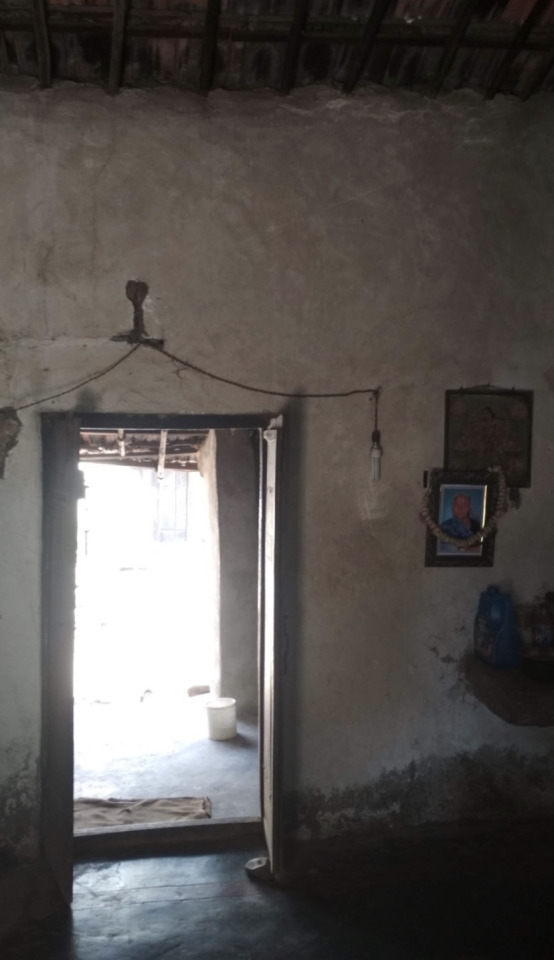

photograph of jamnaben jamariya’s house, after death.
[2/n]
#art#artists on tumblr#tumblr#poetry#writers#art parallels#literature#english literature#photography#susan sontag#on photography
23 notes
·
View notes